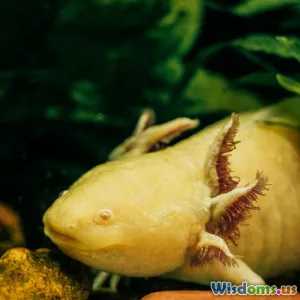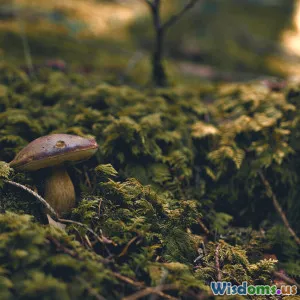
The Surprising Regeneration Powers of Axolotls Explained
9 min read Discover the incredible regenerative abilities of axolotls and what scientists learn from these aquatic wonders. (0 Reviews)
The Surprising Regeneration Powers of Axolotls Explained
Introduction
Imagine losing a limb and magically growing it back—completely functional, just like before. While this may sound like science fiction for humans, in the animal kingdom, this astonishing ability is very much a reality for the Mexican axolotl (Ambystoma mexicanum). What makes the axolotl unlike almost any other vertebrate is its near-limitless regeneration capability, giving it the power to regrow limbs, spinal cord sections, and even parts of its brain without scarring. This incredible biological phenomenon has captivated scientists and medical researchers alike, prompting questions about how axolotls do it and what it might mean for regenerative medicine.
This article will explore the axolotl’s remarkable regeneration abilities in depth, shedding light on the underlying biological processes, how they differ from typical wound repair in other animals, and what promising research is underway to translate these findings into human therapies.
What Are Axolotls?
Axolotls are aquatic salamanders native to the lake complex of Xochimilco near Mexico City. Unlike most amphibians, they retain their larval form throughout life, a condition known as neoteny. This means they live permanently underwater with external gills and never undergo the typical metamorphosis into terrestrial adults. Their striking appearance—smiling faces and feathery gills protruding from either side of their heads—has made them popular pets.
However, the wild populations have sadly plummeted due to habitat loss and pollution, placing the axolotl on the endangered species list.
The Biology Behind Regeneration
How Regeneration Differs from Healing
Unlike most vertebrates that heal wounds primarily by forming scar tissue, axolotls replace damaged tissues with new, fully functional cells identical to the original. For example, if an axolotl loses a limb, the wound closes without scarring, and a new limb forms complete with bones, muscles, nerves, and skin.
This regenerative process is governed by specialized mechanisms:
- Blastema Formation: Upon injury, a structure called a blastema forms at the wound site—a mass of progenitor cells capable of differentiating into multiple tissues.
- Cellular Dedifferentiation: Mature cells near the injury revert to a more primitive, stem-like state allowing them to proliferate and rebuild the lost structures.
- Immune Modulation: Instead of triggering a damaging inflammatory response that leads to scarring, the axolotl’s immune system fosters a regenerative environment.
Genetic and Molecular Drivers
Research has uncovered several key factors involved in axolotl regeneration:
- Growth Factors: Proteins like fibroblast growth factors (FGFs) and transforming growth factor-beta (TGF-β) guide the proliferation and differentiation of blastema cells.
- Wnt/β-catenin Signaling: This pathway plays a crucial role in tissue patterning and limb regeneration.
- Nerve Dependency: Regrowth requires the presence of nerves; without them, regeneration is poor or absent.
Novelties in axolotl genetics, such as their enormous genome (about 10 times larger than the human genome), are being studied to understand gene regulation during regeneration.
Regeneration Beyond Limbs
Axolotls can regenerate more than just limbs. Studies have demonstrated their ability to regenerate:
- Spinal cord: They can repair and restore full function following severe spinal injuries.
- Parts of their brain: Damaged brain tissue, including neurons, can be replaced.
- Heart tissue: They can even regenerate heart muscle after injury.
This multifaceted regeneration ability is rare among vertebrates and underscores the axolotl’s extraordinary biological capacity.
Why Can Axolotls Regenerate So Well?
Despite extensive studies, the full reason why axolotls possess such capacities remains partially mysterious, yet scientists identify several contributing factors:
- Developmental Plasticity: Since axolotls retain juvenile traits into adulthood, their cells remain flexible and retain regenerative capabilities lost in many adult vertebrates.
- Scar-Free Healing: The absence of fibrotic scarring allows for perfect restoration of tissues, unlike typical mammalian wounds.
- Highly Active Stem Cells: The blastema acts like a reservoir of stem-cell-like precursors ready to rebuild structures.
A recent study led by researchers at the University of Kent highlighted the key role of macrophages—immune cells—in coordinating the regenerative response. When macrophages were depleted in axolotls, regeneration failed and scar-like tissue formed. This shows that a specific immune environment is essential.
Scientific and Medical Implications
Axolotls in Regenerative Medicine Research
Because humans have very limited regeneration (mostly minor wound healing and liver regeneration), axolotls present a window into possibilities for regenerative therapies, including:
- Limb Regrowth: Though human limb regeneration is not currently feasible, understanding axolotl mechanisms could inspire strategies to enhance human tissue repair.
- Neural Regeneration: Spinal injuries remain a major challenge; axolotl research may aid development of treatments that restore nerve function.
- Cardiac Repair: Insights into heart muscle regeneration could improve recovery from myocardial infarction.
Genomic and Molecular Tools
The sequencing of the axolotl genome in recent years has accelerated progress. For example:
- Genetic tools like CRISPR/Cas9 are being used to manipulate specific genes in axolotls to better understand their role in regeneration.
- Comparative studies are identifying key genetic differences between humans and axolotls that could be targeted for therapeutic development.
Real-World Breakthroughs
While clinical applications are still emerging, ongoing research has:^1
- Demonstrated partial regeneration in mammals by activating certain genes inspired by axolotls.
- Explored ways to reduce scar formation in humans by modulating immune responses.
These represent promising first steps toward future regenerative therapies.
Conservation and Ethical Considerations
Despite their scientific fame, axolotls face severe threats in the wild. Their limited natural habitat is shrinking rapidly due to urbanization and pollution. Protecting wild populations is critical not only for biodiversity but also to preserve their ecological and scientific value.
Ethical questions also arise in laboratories. As demand for axolotls increases in research, ensuring humane treatment and sustainable practices is paramount.
Promoting environmental awareness and supporting axolotl conservation efforts like the Xochimilco restoration project are vital.
Conclusion
The axolotl’s astonishing regeneration powers open a remarkable window into biological resilience and potential healing miracles that humans have yet to harness. Understanding how these aquatic salamanders can regrow limbs, repair spinal cords, and restore organs without scars brings us closer to revolutionary advances in regenerative medicine.
While many questions remain—from the exact molecular mechanisms to safely translating these traits to humans—the axolotl stands as a beacon of possibility, inspiring both scientists and nature enthusiasts.
From conserving their natural habitats to advancing cutting-edge genetic research, the study of axolotls symbolizes hope that one day, humans might unlock similar powers to heal, renew, and transform health outcomes.
References:
- Whited, J. L., & Tabin, C. J. (2009). Limb regeneration revisited. Journal of Biology, 8(5), 5.
- Godwin, J. W., et al. (2013). Macrophages are required for adult salamander limb regeneration. Proceedings of the National Academy of Sciences, 110(23), 9415-9420.
- Nowoshilow, S., et al. (2018). The axolotl genome and the evolution of key tissue formation regulators. Nature, 554(7690), 50-55.
Embrace the axolotl's secrets—they just might inspire humanity's next great leap in healing.
Rate the Post
User Reviews
Popular Posts



















